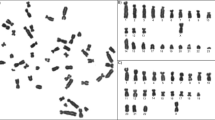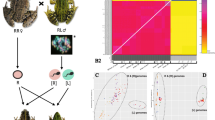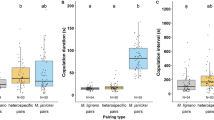Abstract
Corson1 and Potts2 record crossing Glossina swynnertoni Aust. with G. morsitans Westwood. Corson crossed twelve female G. morsitans with male G. swynnertoni, of which only two females produced a total of three pupæ. All his females lived long enough for reproduction to take place. He records the offspring, all females, as being identical with pure-bred G. morsitans, and suggested parthenogenesis. Potts crossed both male G. morsitans with female G. swynnertoni and male G. swynnertoni with female G. morsitans (see accompanying communication by Mr. W. H. Potts).
This is a preview of subscription content, access via your institution
Access options
Subscribe to this journal
Receive 51 print issues and online access
$199.00 per year
only $3.90 per issue
Buy this article
- Purchase on Springer Link
- Instant access to full article PDF
Prices may be subject to local taxes which are calculated during checkout
Similar content being viewed by others
References
Corson, J. F., J. Trop. Med. and Hyg. (April 1932).
Potts, Bull. Ent. Res., 28, 129 (1937), and unpublished data.
Author information
Authors and Affiliations
Rights and permissions
About this article
Cite this article
VANDERPLANK, F. Hybridization between Glossina Species and Suggested New Method for Control of Certain Species of Tsetse. Nature 154, 607–608 (1944). https://doi.org/10.1038/154607a0
Issue Date:
DOI: https://doi.org/10.1038/154607a0
This article is cited by
-
Reproductive interference and Satyrisation: mechanisms, outcomes and potential use for insect control
Journal of Pest Science (2022)
-
Transforming insect population control with precision guided sterile males with demonstration in flies
Nature Communications (2019)
-
On an integro-differential model for pest control in a heterogeneous environment
Journal of Mathematical Biology (2015)
-
Unexpectedly slow homogenisation within a repetitive DNA family shared between two subspecies of tsetse fly
Journal of Molecular Evolution (1984)
-
X-Chromosome involvement in male hybrid sterility from Glossina morsitans sub-species crosses
Heredity (1980)
Comments
By submitting a comment you agree to abide by our Terms and Community Guidelines. If you find something abusive or that does not comply with our terms or guidelines please flag it as inappropriate.



